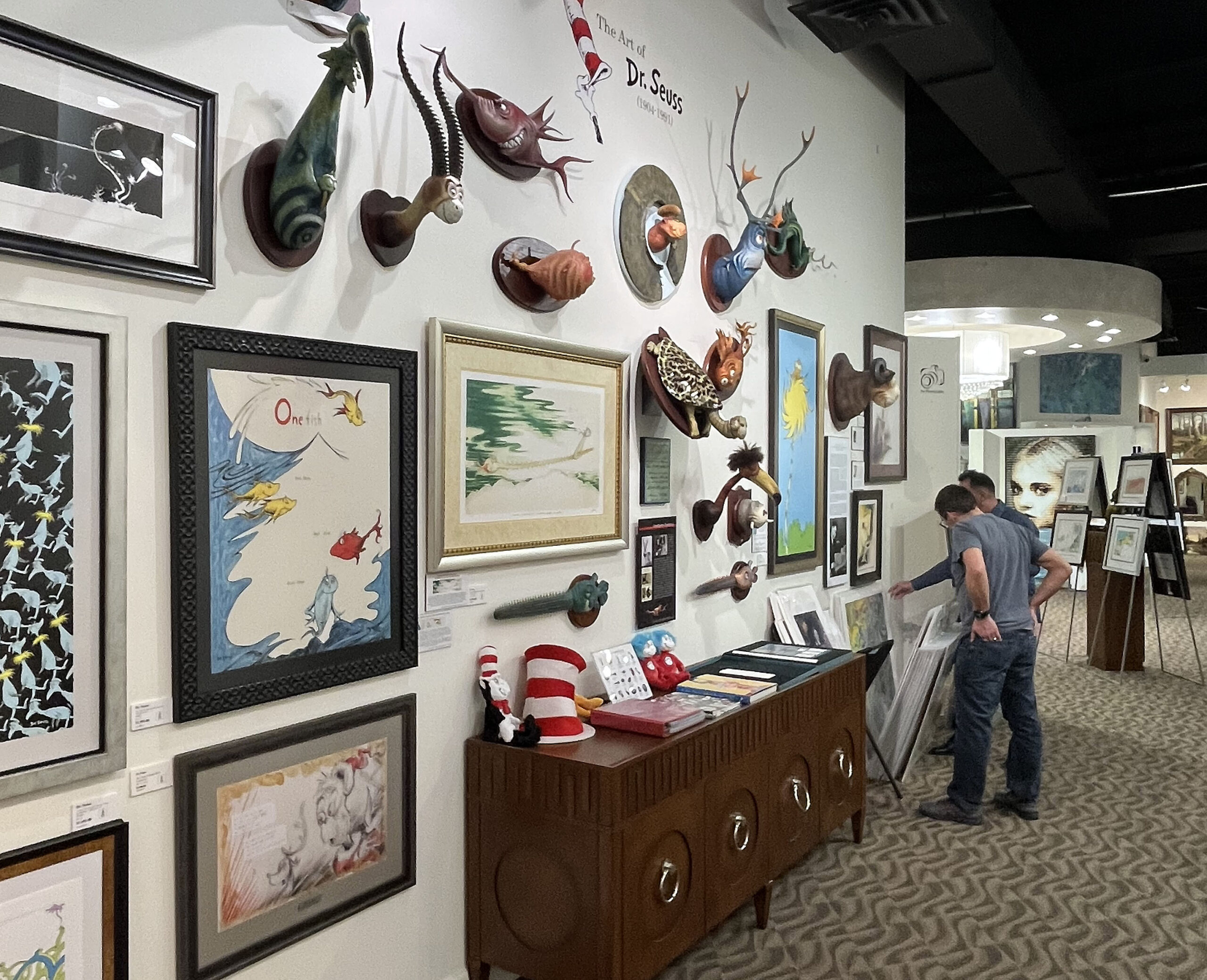
An installation view of Look At Me! Look A Me Now! Exhibition at West Bloomfield’s Art Leaders Gallery, up through March 30.
In a treat for anyone who loves cartoons, The Imaginative, Profound & Magical World of Dr. Seuss: The Rare Editions Exhibition will be up at Art Leaders Gallery in West Bloomfield through March 30, 2024. On Saturday, March 23, the gallery will host a special open house for the Seuss exhibit from 3 to 6 p.m.
This show of prints and sculptures, which you’ll find at the center of the Art Leaders space, is surprisingly magnetic. On display are a number of treasures that will appeal to fans, including several “before and after” pairings, where the original rough draft – with multiple, seemingly messy lines working out each visual element – is framed in a diptych with the polished, final version. It makes for fun viewing and gives a little glimpse into the process that produces what looks like simple art.
Consider the two versions of Look at Me Now, starring Seuss’ best-known creation, the Cat in the Hat, who’s juggling all manner of breakable items while balancing on a ball. It’s classic Seussian absurdity, and an almost universally recognizable childhood image.
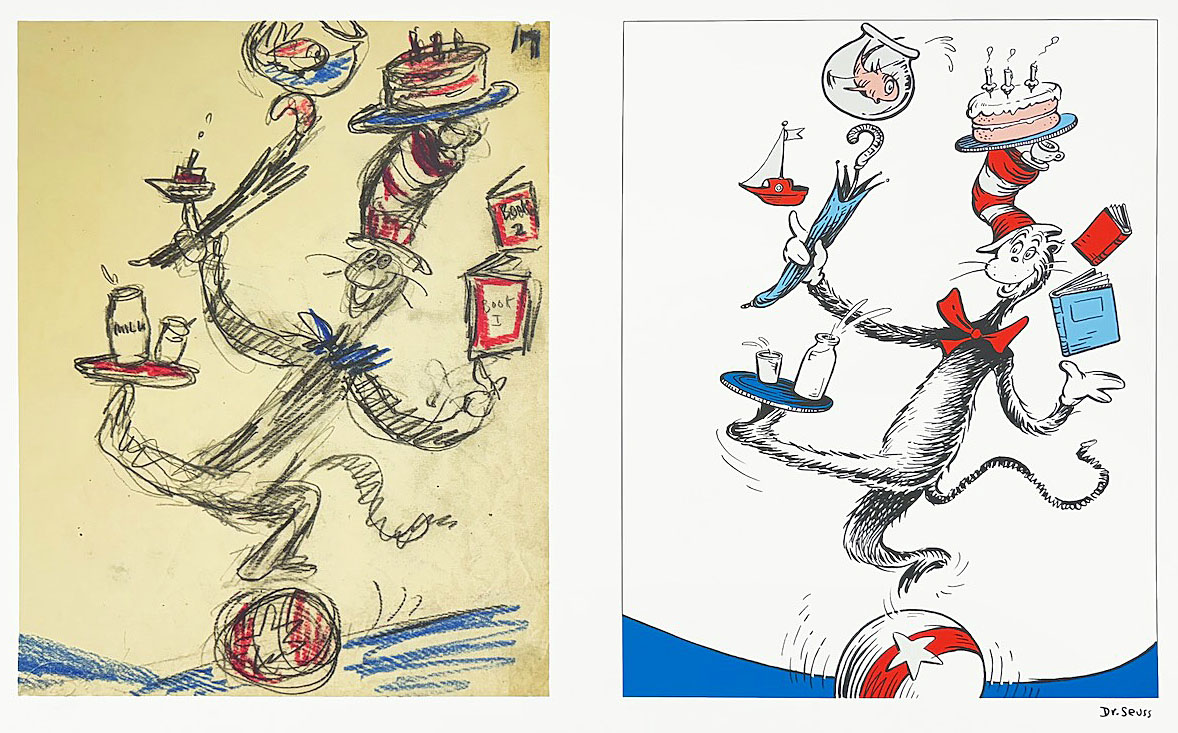
Dr. Seuss, Look At Me Now!, Look At Me Now!, Diptych, 26.5 by 17.5 inches. (Photos courtesy of Art Leaders Gallery.)
Dr. Seuss published his first children’s book, “And to Think I Saw That on Mulberry Street,” in 1937. But it was “The Cat in the Hat” exactly 20 years later that really catapulted the artist into the pop-cult stratosphere. It was fame that never flagged. His death in 1991 at 87 prompted all sorts of elegiac summaries: In its front-page obituary, the New York Times called Seuss “the modern Mother Goose,” while Time Magazine declared he was “one of the last doctors to make house calls – some 200 million of them in 20 languages.”
(“The Cat in the Hat,” by the way, was significant not just for its unhinged hero — who generated childish excitement and anxiety in equal measure — but also because it employed a limited vocabulary of about 220 “beginner’s words” recommended by reading specialists. Seuss then wrote it all up in a cadence — “anapestic tetrameter,” if you must — that was particularly easy for young readers to master and learn. From there on in, his books aimed to make learning how to read fun – quite a shift from the old “Dick and Jane” primers of the time.)
One of the charms of Seuss’ work, of course, has always been its complete lack of pretension and his willingness to make fun of himself. Four months after the launch of “Cat in the Hat,” the Saturday Evening Post helped the artist do just that when it ran what would become the most-iconic Seuss self-portrait, The Cat Behind the Hat – featuring the good doctor as his famous feline, looking dyspeptic, complete with stovepipe hat – in its July 6, 1957 issue.
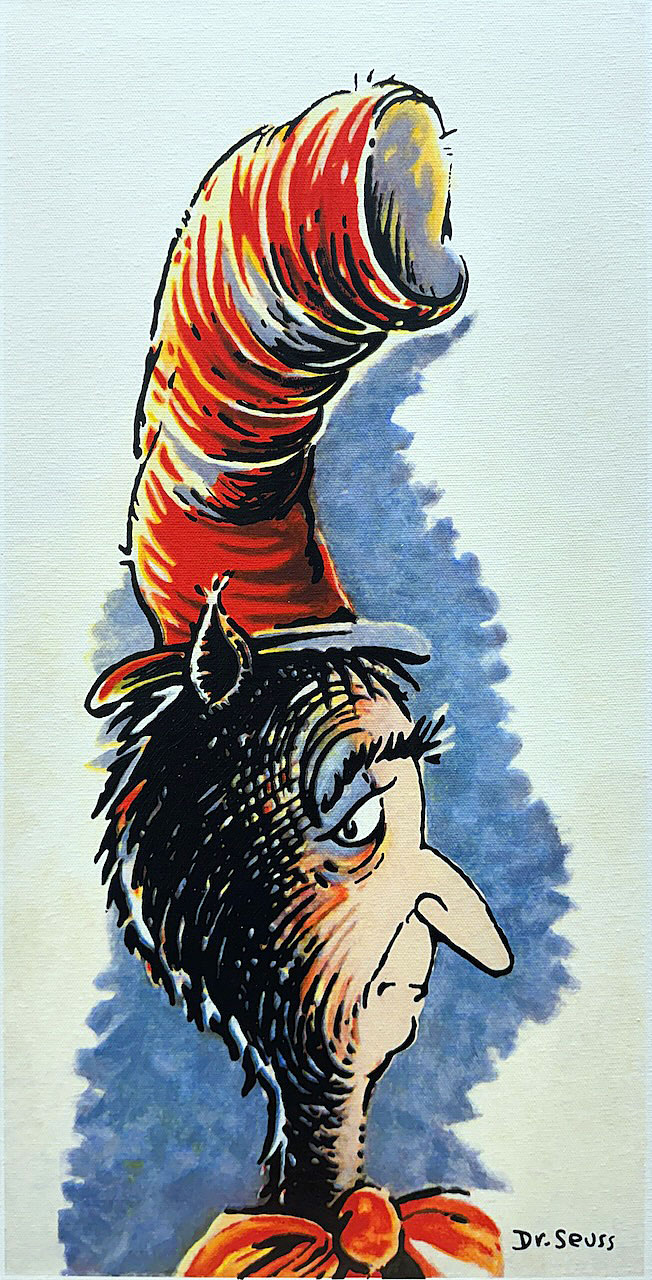
Dr. Seuss, The Cat Behind the Hat, 20 by 10 inches.
Theodor Seuss Geisel – aka Dr. Seuss – initially got his start in advertising. Two years out of Dartmouth College in 1927, the young Geisel, from Springfield, Massachusetts, got a job drawing ads for “The Flit” — a household insecticide spray Standard Oil of New Jersey produced which promised to kill almost anything that crept, fluttered or crawled. Charmingly, the style of one ad from the early forties is unmistakably Seuss-ian, with an impish bug in a red-striped shirt who’s just flown right through a woman’s fancy hat, sparking predictable outrage.
Once Seuss was working full-time on children’s literature – his output was staggering – he took to working on his own personal art at night and on weekends, much of which is in the Art Leaders exhibition. Some, like the luridly colored Worm Glowing Bright in the Forest in the Night, approach abstract expressionism, albeit with the puckish intrusion of a befuddled yellow worm. Others, like Life’s a Great Balancing Act, play with patterns in a way that’s slightly reminiscent of Escher, but always, again, with a dash of oddball humor.
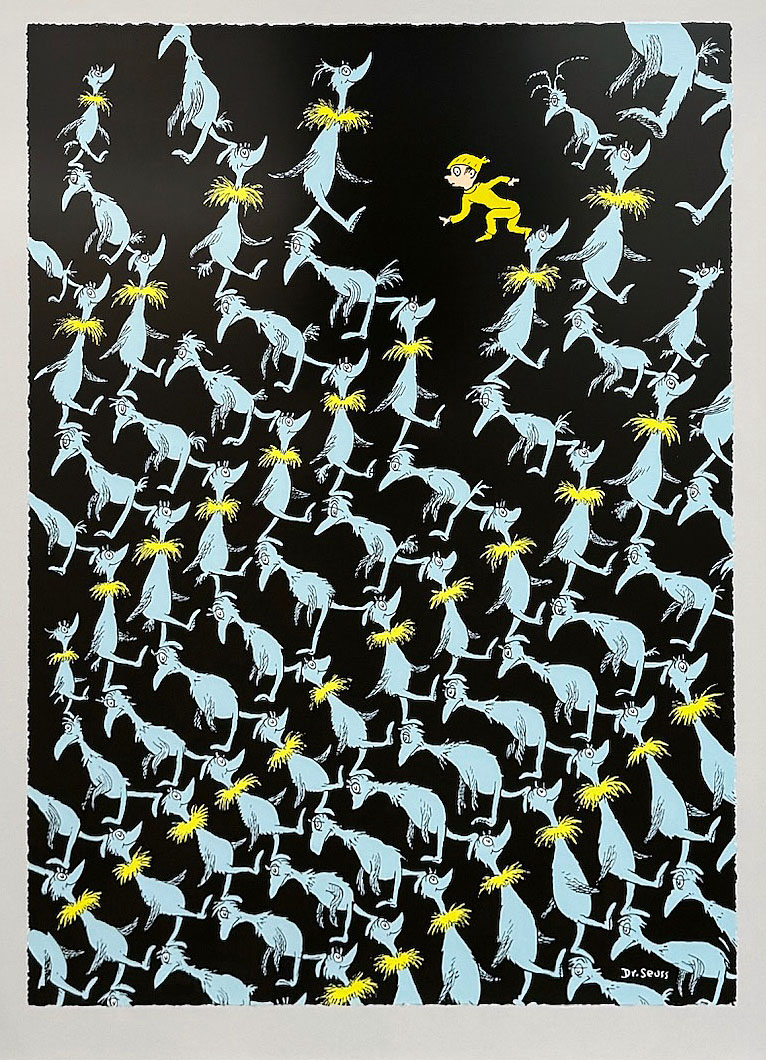
Dr. Seuss, Life’s a Great Balancing Act, 30.75 by 22 inches.
A man of his times, Seuss has, perhaps inevitably, come under fire for depictions of minorities that now seem tone-deaf and condescending. The Amazing World of Dr. Seuss Museum in Springfield, Massachusetts, announced in 2017 that it would replace a mural that included such images. And in 2021, the Seuss estate said it would voluntarily stop selling six titles, including Mulberry Street, thought to contain egregious examples of racial and ethnic stereotypes.
Happily, the art in this spirited exhibition avoids those sorts of dated allusions. Most just underlines Dr. Seuss’ gift for enchanting idiocy, and his ability to spin magical, gossamer worlds out of thin air. His approach is almost unfailingly gentle, indulgent, and tolerant of the frailties of this brittle world. In Seuss-land, all human rancor can be boiled down to the contentious standoff between two neighbors featured in My Petunia Can Lick Your Geranium, competing over who had the better garden.
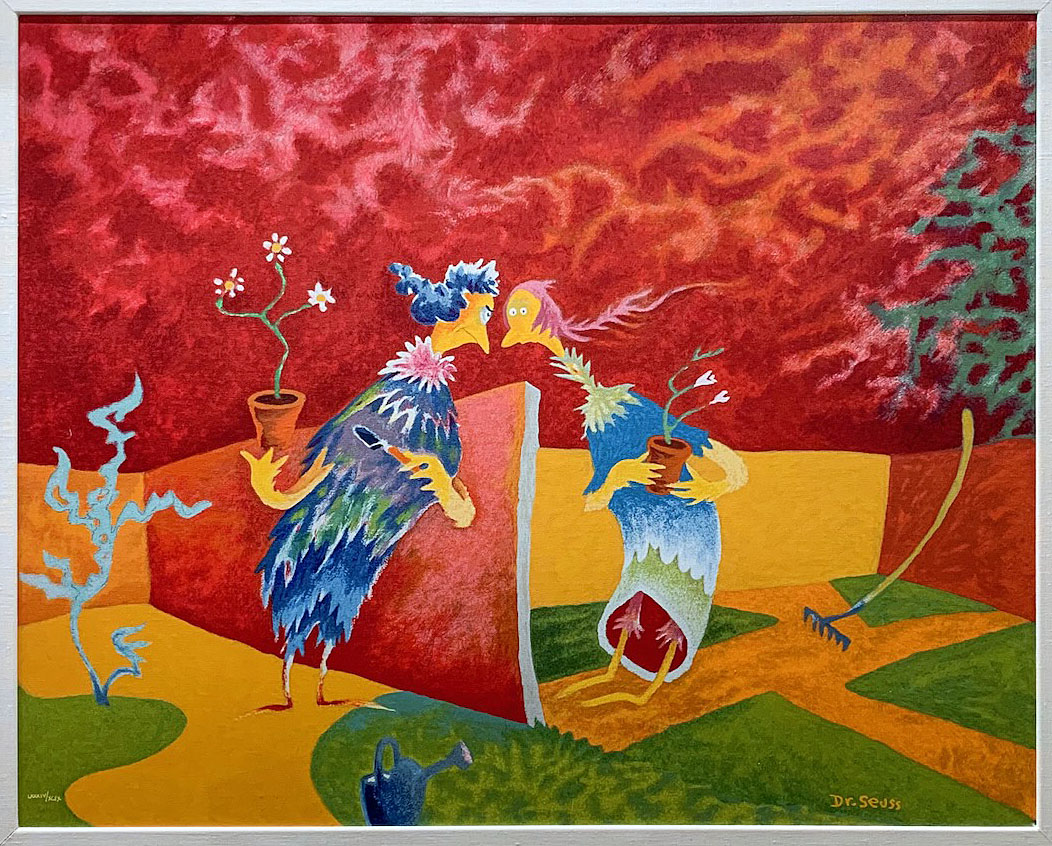
Dr. Seuss, My Petunia Can Lick Your Geranium, 27 by 34 inches.
The publisher of The Art of Dr. Seuss, Robert M. Chase, notes that almost everyone has a “significant Dr. Seuss memory” and that any number of creative artists and writers acknowledge the master’s influence on their work. “Indeed,” writes Chase on the website of the same name, “what Walt Disney was to entertainment, Theodor Seuss Geisel was to art and literature.”
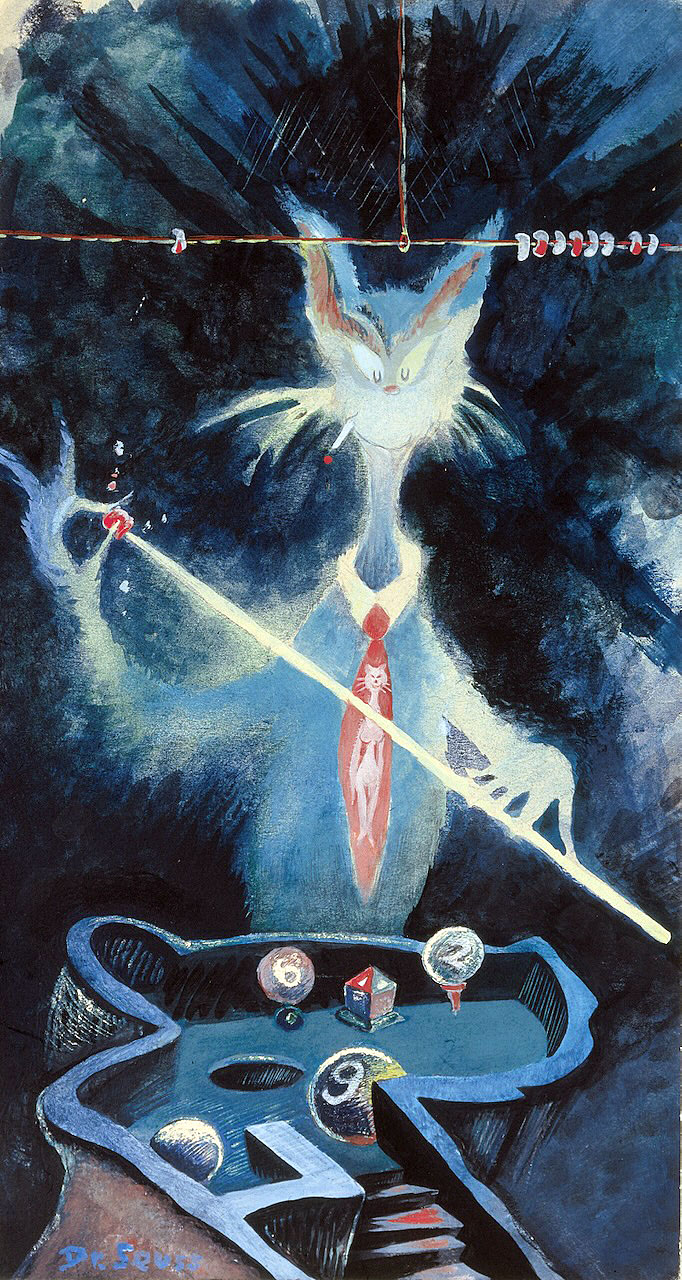
Dr. Seuss, Cat from the Wrong Side of the Tracks, 22 by 44 inches.
The Imaginative, Profound & Magical World of Dr. Seuss: Look At Me! Look At Me Now! The Rare Editions Exhibition will be at West Bloomfield’s Art Leaders Gallery through March 30, 2024.
